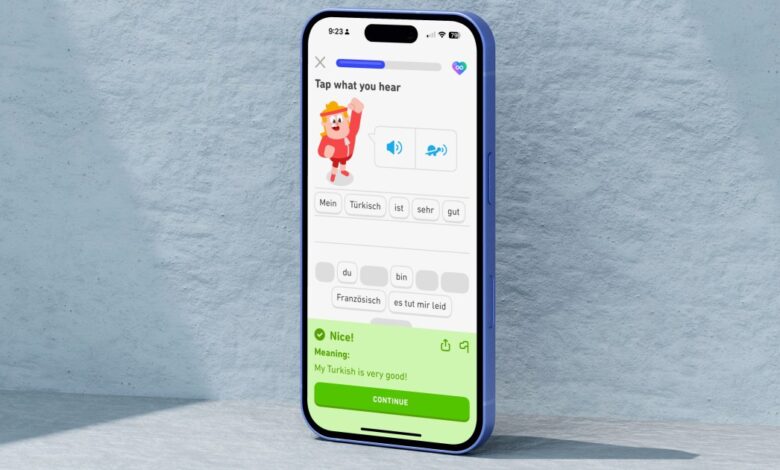I use all the popular language learning apps and these are my favorites for becoming fluent

In June, I’m excited to visit Germany, Austria, and Switzerland for the first time as a chaperone for my daughter’s class trip. This trip has been in the making for nearly two years, and to get ready, I’ve been diving into learning German. I’ll be honest, when I started this process, I was a bit unsure. Like many Americans, I didn’t try to learn a second language until I hit middle school, and that language was Spanish. After spending about five years in classes, I can only grasp the basics now.
This time around with German, I’m taking a different approach—using language learning apps, just like millions of others do instead of sticking to traditional classrooms.
So, which apps are worth your time? After giving quite a few of them a shot, I’ve narrowed it down to five impressive options. Each app takes a unique approach to learning languages, catering to different types of users. Hopefully, you’ll find just the right app for your needs below.
The best of the best, Duolingo
Learning a new language is a journey that takes time, and one of the most effective motivators app developers use to keep users engaged is a reward system. A standout in this sphere is Duolingo, which happens to be my favorite language-learning app. It’s known for its gamified approach, transforming the learning process into an engaging and enjoyable experience.
For anyone eager to pick up a new language in just a few months, Duolingo offers a friendly and structured method to enhance vocabulary and grasp basic grammar through interactive lessons. The app features short, bite-sized exercises that focus on translating sentences, listening comprehension, and even pronunciation practice. Its spaced repetition technique is a game-changer, reinforcing learned words and phrases, which helps with retention.
What I love most about Duolingo is how easy it is to use—it’s incredibly accessible, allowing you to practice whenever you have a few minutes to spare, making it perfect for those of us with busy schedules. Plus, it supports a wide range of languages, including some less commonly taught ones like Hawaiian and Klingon. However, I do find that Duolingo isn’t the best option for mastering conversation skills. Its focus tends to lean more toward translation rather than real-world interactions. Also, while it introduces grammar concepts, it doesn’t always provide the in-depth explanations that some learners, like myself, might find helpful for truly understanding sentence structure better.
Duolingo also offers a paid subscription called Duolingo Super (formerly Duolingo Plus), which eliminates ads, allows for unlimited mistakes in lessons, and enables offline learning. This typically costs about $6.99 per month or $83.88 per year. There’s an even higher-tier option called Duolingo Max, which includes AI-powered conversation practice along with advanced review features. Overall, while I think Duolingo is fantastic for building foundational language skills, I believe that pairing it with conversational practice and additional resources is crucial for achieving full fluency.
Currently, you can learn up to 40 languages using Duolingo.
Best for conversational learning, Pimsleur
If you’re eager to learn a new language quickly and effectively, Pimsleur could be exactly what you’re looking for. This well-established language learning app is perfect for those who prefer an audio-based approach, focusing on listening and speaking rather than traditional textbooks. With its scientifically backed methodology that emphasizes spaced repetition and active recall, you’ll be retaining vocabulary and grammar naturally, making learning feel seamless.
One of Pimsleur’s significant perks is its hands-free learning experience. You can practice while commuting or juggling other tasks, turning any spare moment into a valuable learning opportunity. However, it’s important to note that Pimsleur’s audio focus means it lacks interactive exercises for reading and writing, which might not suit everyone’s learning style.
Pimsleur offers flexible subscription plans designed to fit different learning needs. The Premium plan is priced at $19.95 per month and gives you access to one language. If you’re looking to dive deeper, the All Access plan is available for $20.95 per month, allowing you to explore all 51 languages offered on the platform. For those committed to long-term learning, the All Access Annual plan costs $164.95 per year (about $13.75 per month), providing great value. Plus, each plan comes with extras like flashcards, quizzes, speed games, and role-playing tools that enhance the learning experience. You can even try it out with a 7-day free trial to see if it’s a good fit for you before committing.
While Pimsleur’s pricing is competitive compared to private tutoring or immersive programs, some may find it a bit higher than other language apps that include more interactive content.
Overall, Pimsleur is an excellent option if you want to build conversational skills and pronunciation in a structured and flexible way. If you thrive on audio-based learning and aim to quickly develop practical speaking abilities, Pimsleur could truly be a valuable tool in your language-learning journey. But, if you lean towards more interactive or visual learning methods, it might be worth exploring other options as well. Let me know if you’d like recommendations for alternatives!
With Pimsleur, you can now learn over 50 languages.
Best for traditional learning, Babbel
Babbel is a fantastic language-learning app for anyone eager to pick up a new language in just a few months. It features structured courses in 14 languages, like Spanish, French, German, and Italian, making it a flexible choice for learners. One of its standout qualities is its practical approach—lessons emphasize real-life conversations instead of mere vocabulary memorization, helping boost your confidence in speaking. Plus, Babbel’s speech recognition technology enhances your pronunciation, and personalized review sessions solidify what you’ve learned. If you prefer a classroom vibe, Babbel Live offers interactive, instructor-led classes online.
While it’s perfect for beginners and intermediate learners, advanced users might find the content limited, as it doesn’t deeply explore complex linguistic structures.
Babbel provides several subscription plans to fit your learning goals and budget. You can choose a monthly plan for $12.95 or a yearly one for $83.40, which is more economical in the long run. There’s also a range of options: 1-month, 3-month, 6-month, and 12-month plans priced at $15, $45, $90, and $180, respectively, though discounts frequently lower these prices to $15, $38, $63, and $80. If you’re committed for the long haul, you can grab a lifetime subscription for $200, down from $599.
In summary, Babbel is a solid choice if you want structured, practical lessons that focus on conversational skills. Its flexible pricing and interactive features make it a valuable tool, although you might want additional resources for advanced fluency. Looking for recommendations for other language-learning apps?
Best for advanced learners, LingQ
LingQ is a fantastic language-learning app, especially if you’re eager to dive into a new language within just a few months. Unlike many traditional apps that stick to structured lessons, LingQ lets you learn naturally by immersing yourself in authentic content like articles, podcasts, and books. This way, you’ll absorb the language better through real-life exposure rather than rote memorization.
One of the best features of LingQ is that you can import your own content, which means you can tailor your learning experience to match your interests. Whether you’re into Spanish, French, Japanese, or Russian, LingQ has got you covered with support for over 40 languages! Plus, the app comes equipped with helpful tools like flashcards, interactive lessons, and vocabulary tracking to make your learning process even more effective.
On the downside, some users find LingQ’s interface a bit tricky to navigate. You might also notice that less common languages have limited content, which could be a hurdle for some. Additionally, while the app excels in reading and listening, it doesn’t emphasize speaking practice as much, so you might want to explore some conversation-focused tools to complement your learning.
When it comes to pricing, LingQ offers a range of options to fit your learning style and commitment level. The monthly Premium plan is $14.99, but if you opt for the annual subscription at $119.99, you’ll only pay $10 per month. For the long-term learners, there’s a two-year plan at $215.76, which lowers your monthly cost to just $8.99. If you’re looking for extra support, the Premium Plus plan, which includes tutoring services, costs $39.99 per month, with discounts available for longer subscriptions. And don’t worry, there’s a free version too, although it has some limits on saved words and imported lessons.
Overall, LingQ is an excellent choice if you prefer a self-directed and immersive approach to learning through reading and listening. With its flexible pricing and expansive library of content, it’s a valuable resource for language learners. Just keep in mind, if you’re after structured lessons or want to practice your speaking skills, you may need to look for additional resources to support your journey.
Best for immersion, FluentU
FluentU is a fantastic language-learning app tailored for those who learn best through visuals. It offers an immersive experience with thousands of short video clips. I love how it focuses on listening comprehension, using real-world videos like movie trailers, music videos, and news clips. This method helps teach vocabulary and phrases in a way that feels relevant and enjoyable, especially if you prefer a natural approach to picking up a new language. However, it’s worth noting that FluentU doesn’t include speaking exercises or speech recognition technology, so you won’t get much practice speaking the language.
FluentU offers two subscription plans: a flexible monthly option for $30 or an annual plan that costs between $12 and $20 per month, depending on current promotions. While this pricing might feel a bit steep compared to competitors like Babbel and Pimsleur, it does allow access to multiple languages under one subscription. This is a great perk if you’re a polyglot or interested in diving into more than one language at a time. Still, some users may find it expensive, particularly since the app mainly emphasizes listening skills rather than a well-rounded approach that includes speaking and writing.
Overall, I think FluentU is a solid choice for learners eager to enhance their listening abilities and broaden their vocabulary through engaging video content. However, if you’re looking for a more structured learning experience that includes speaking practice, you might want to consider supplementing FluentU with other language-learning tools.





